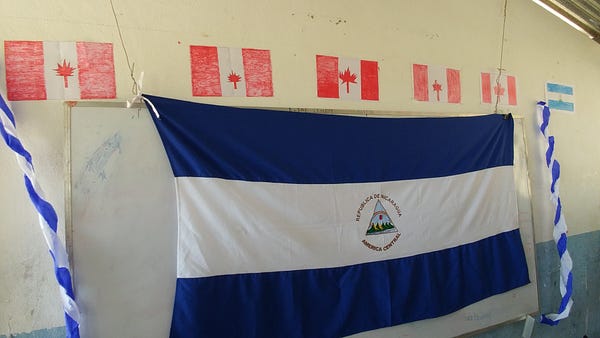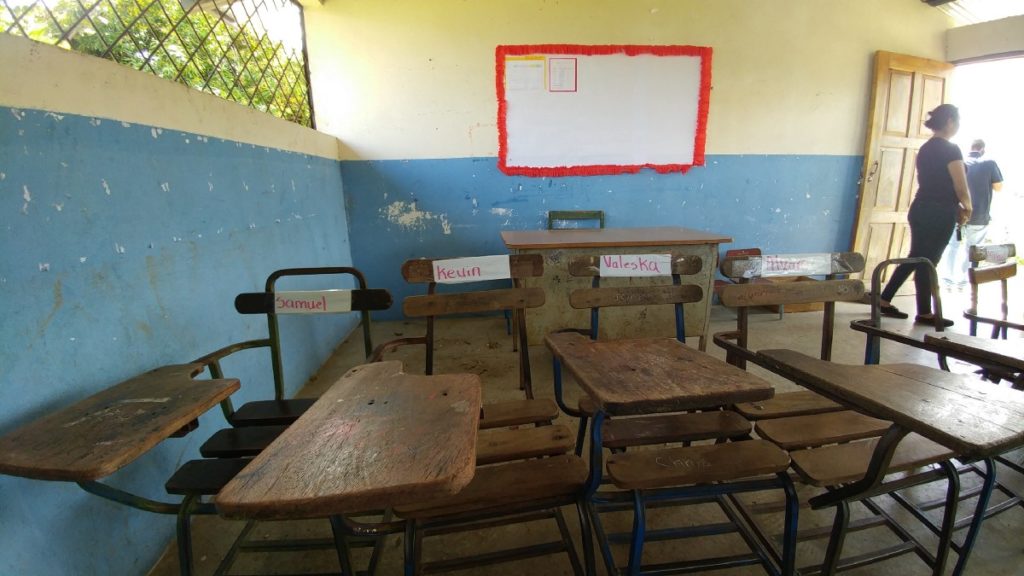SOS’s Executive Director, James Arron, spent 10 days visiting partnering organizations and communities in Nicaragua and Costa Rica in March 2017.
Schoolhouses marked with blue and white stripes cover Nicaragua. The design is now standard on all new builds. But there are still classrooms of different colours leftover from an era prior; the age before the revolution. They are still in use, and teachers still receive their government salaries, but they are not “officially recognized”. The result is the government is no longer responsible for their maintenance.To my uninformed perspective it seems like an arbitrary line to draw: the blue & white schools get electricity and books and new doors, whereas the others don’t.
But such is the complexity of education in this country; considered the 2nd poorest in the Americas. By all accounts, the government is serious about its investments in education and health (albeit still battling pervasive corruption). Yet, there are more needs than there are resources and this seems to be some form of convenient way to set the priorities.
Its part of my lesson in the ways of Nicaragua’s education system. Its foreign to my own childhood experience. Class schedules are often dictated by the time of year to accommodate the long walks students typically need to make through the rainy season and the needs of parents who sometimes need the extra labour of their children to make ends meet.
Classrooms typically combine at least three grades. Schooling is considered mandatory until only grade 6. Still many do not make it that far, but after that attendance drops sharply. For those that go on, secondary school takes place just once a week, on Saturdays, to make use of the free space of the elementary schools on weekends.
Yet despite the challenges, like any school there are still drawings hung upon the walls, still teachers speaking about their passion for their jobs, still there is a roll call for what students are on cleaning duty each day, and what parents are on rotation to cook the morning snacks provided by the government.

The challenges are daunting but it seems the only option is to persevere. Everyone recognizes the importance of education, but with only so many resources some things on the list of needs simply don’t make the cut. I’m told its been years since the government has built any new schools in the remote highland regions in which most our projects are based.
From a logistical lens it’s understandably difficult to provide services to villages of just a few hundred people. Yet, do these kids of the highland villages not still have the right to a basic education, a right supposedly guaranteed by international agreements? These families, who grow the coffee we Canadians drink each day — earning $180/lb while the same product earns multinationals about $12,000/lb — they express solemnly their dreams for their kids, knowing they are fighting against all odds to make them come true. But the basic literacy taught to the children through the new school provides immediate results. They share stories of how their kids now help them to read the prescriptions written by their doctors, and share lessons about the environmental and health impacts of various household practices.
While the government has stopped funding construction of new spaces in this region, they are still involved in the process and recognize their responsibility to keep them going once established. The Sandinista principles and government policies dictate the classrooms will be sustained with teacher salaries, books, and ongoing support once built.
I come to believe in building a school we are kick-starting a process; supporting basic literacy and all the spin-off benefits that entails, allowing these children a chance to set their own course for the future, and enabling an opportunity . Its one small piece of a bigger puzzle, but I leave convinced of its importance.

